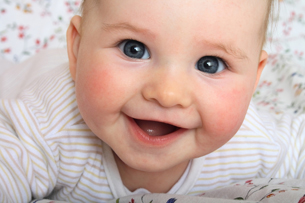Module 4
1. Module 4
1.15. Page 4
Module 4—From Fertilization to Birth
 Lesson Summary
Lesson Summary

© Jiri Vaclavek/Shutterstock
The following focusing questions were addressed in this lesson:
- What triggers the birthing process and what are its stages?
- What controls lactation?
Parturition is divided into three stages, although the events occur as a continuous process. Labour is separated into the dilation stage (uterine contractions begin), the expulsion stage (delivery of the fetus), and the placental stage (the discharge of the placenta).
Labour is initiated and sustained through nervous and hormonal control. Oxytocin and prostaglandin stimulation works through a positive feedback mechanism to promote further uterine contractions. Uterine contractions force the fetus down to the cervix and out through the birth canal. They also cause the placenta to be expelled from the body after birth. If a normal vaginal birth is not possible, it is common for delivery of the fetus to occur through a Cesarean section.
Once the fetus is delivered, it can no longer rely on its mother for air, food, or the elimination of its wastes. All of the baby’s body systems that perform these functions now begin working independently. For the infant to acquire nutrition, it needs to be breast or bottle fed. In breast feeding, the hormone prolactin causes the production of breast milk. The release of oxytocin due to suckling stimulation causes the mammary glands to secrete breast milk.
The desired end result of this reproductive process filled with development and change is the glowing face of a healthy newborn baby.
Lesson Glossary
Caesarean section (C-section): a surgical procedure in which the fetus is removed from the abdomen through an incision; used when vaginal birth is difficult or impossible
colostrum: a rich, yellow secretion from the mammary glands that occurs for two to three days prior to the first secretion of milk; contains mother’s antibodies to protect the newborn from disease
contractions: the rythmic shortening of the muscles of the uterus to expel the fetus
dilation: the opening of the cervix to allow passage of the baby
dilation stage: the stretching and opening of the cervix to 10 cm to allow passage of the fetus during expulsion
expulsion stage: the stage in which the smooth muscle walls of the uterus contract in rhythmic cycles to deliver the fetus from the vagina
parturition: the process of labour and delivery, which is divided into dilation, expulsion, and placental stages
placental stage: the stage in which further uterine contractions push the placenta out of body through the vagina; also known as delivery of the afterbirth
prostaglandins: a group of hormones that contribute to parturition by thinning the cervix and increasing contraction of the uterus
sucking reflex: an instinctive sucking action by a newborn that stimulates oxytocin secretion in the mother; results in release of milk from the mammary glands into the milk ducts of the breast